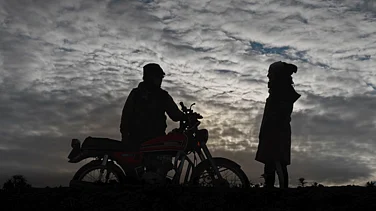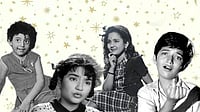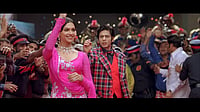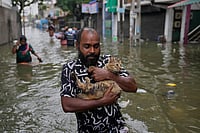
Zarna Garg is an Indian American stand-up comic with shows on Netflix and Amazon.
Her jokes on Indian stereotypes and the immigrant experience got her a huge following during Covid.
Stuck in a time-warp of India in the nineties, Zarna Garg needs to find new material to stay relevant, as her humor is losing its shine.
Zarna Garg loves vampire facials and Hermes bags, wants everyone to be a doctor and would rather spend 1000 dollars on a Prada chappal than a Kolhapuri because the latter is “too uncomfortable” for her feet.
She is a social-media star and an Indian-American comedian who monetized mother-in-law jokes. I googled various permutations and combinations of “Zarna Garg mother-in-law” but found nothing. The only one I found was one in which Garg says that her mother-in-law posts negative reviews of her book online. She also makes fun of her husband and children, and gets paid for it across platforms. She is what my resident GenZ would call “Content pick me.”
I don’t know at what point Garg slid into my feed but I had to work very hard to get her out of it. How many of the same mother-in-law jokes, ‘immigrants don’t have servants’, ‘my children are expensive’ and ‘my husband is an idiot’ jokes can you ingest? Besides, the borderline self-hating jokes, the internalised racism, at a time when Indians are already hated online seemed problematic to me. I asked my friends and no one found her funny, but there she was, breaking the internet.
Who then, finds her funny? Is it Indian techies who left for the US in the 90s and early 2000s on H1Bs and who are now whitewashed and jaded from their jobs and their wives are teaching Zumba or Bollywood dance in their local community centres? Or NRIs and foreigners, because her content validates their ideas about Indians? Or worse, Clueless White Americans? But aren’t white people already making enough stereotypical comments about brown people that we need to add Garg to the mix?

In the current Indian reality, the patriarchal stuff mother-in-laws say is not funny, neither are gendered jokes or race stereotypes. These are not appropriate levers for humour, so I figured someone will tell her she needs to upgrade her material? And yet, the more things change, the more they stay the same in Garg’s world.
Things were not adding up, so I figured reading her book, This American Woman: A One-in-a-Billion memoir would fill in some blanks. It didn’t. But I found some gems.
The youngest in a conservative and affluent business family in South Bombay, with three much older half-siblings, she was the baby of the house who strangely no one paid much attention to. She loved reading—her father believed English was the language of success. But he disliked her reading. Little Zarna began her day with The Times of India at age three (and still does) and was reading Sidney Sheldon's If Tomorrow Comes at age eight. The parent in me shuddered.
She was her (much) older half-brother’s pet and he took Little Zarna to watch slasher movies, adult movies, Saturday Night Fever, and even bought her a disco ball, which they had to hide from their father. All this got me really confused.
After her mother (her father’s second wife) died when Garg was 14, her father declared, “I am done parenting”, and suggested she get married. He was ready for wife no. 3, and eligible women had already started making a beeline. She allegedly ran away from home and "couch-surfed" for two years in and around Nepean Sea Road in Bombay (which is smaller than 84th and Broadway). And yet she never ran into her father or her servants in those two years, and kept attending school (what school was this, I googled) until she turned 16, and returned home to face marriage.
Two years of "couch-surfing" in South Bombay with school friends, relatives of friends, and relatives of relatives and no one called her father? Zero family intervention, no cops summoned, no NGOs, no one called Childline? This is not the affluent Bombay I know. I googled some more.
Turns out, as she couch-surfed, a plan was in place with her older half-sister in the US to get her to immigrate. The day she agreed to meet a prospective suitor for marriage, lo and behold, she received a telegram alert from the US Consulate that her student visa was ready! I did google “telegram in India 1991.”
Her sister and brother-in-law funded her US college education for a degree in finance and then, went on to fund her for law school, post which she had a not-so-successful career as a litigation attorney, which means she never paid them back. I was envious.
Cut to two decades later, in which time she arranged herself to be married to a hedge fund guy in Manhattan and had three children. After being a stay-at-home mom for 16 years (“In America, no one has servants like in India," she explains), she wanted to reinvent herself. She couldn’t go back to law, as she believed she wasn’t a good lawyer, but her kids told her she was funny (un-ironically) and she ended up at the basement of a Mexican restaurant in New York on open mic night. She quickly figured that to get on a show, any show, you have to bring in people so that the club can make money through food or drinks. And “an Indian woman comedian” (in salwar kameez and bindi) was so rare that when she put word out to five people, 100 people showed up. Eventually, she graduated from open mics and started producing her own stand-up shows, because, lawyer logic. Soon she could pull in crowds even on a Tuesday or Wednesday night when most comedians couldn’t.

The rest was PR wizardry: She opened for Tina Fey and Amy Poehler for their Restless Leg Tour (they allegedly loved her TikTok videos); she had an Amazon special in 2023 (Zarna Garg: One in a Billion); a Netflix special in 2024 (Practical People Win); a movie (A Nice Indian Boy,2024) and she is friends with Karan Johar (although she claims she is too expensive for Bollywood). She was a guest on The Tonight Show Starring Jimmy Fallon and the Late Night With Seth Myers show during the release of her book earlier this year. And now, she has a family podcast and is developing a sitcom called Zarna with Mindy Kaling and Kevin Hart. If I was her mother-in-law, I would want to be her business partner.
In an interview with Brittany Frederick, she said, “I think in law school you learn to write logically, and that helps me with my joke writing, believe it or not. It helps me write jokes that are really tight and neat, and go from point A to point B without getting all torturous in their logic.”
Her logic is about right. Within a week of COVID and the lockdown, she had transitioned to Zoom shows. “What can I as a human being offer to people at a time when everybody’s depressed?” she said in another interview. The shows were free for the first lot of responders until she realised she could do it as a business. By the end of the pandemic, she was a Covid Comedy star, the Lilly Singh of stand-up comedy!
Mainland Indians discovered her after the "fart all you want" video which went viral a few years ago and she cashed in that popularity by claiming to represent Indian women of her generation all over the world. She was Aunty Funny on TikTok and broke its algorithm and now is all over Instagram.
But there has to be more to the Indian-American experience than "If you are Indian, you will become a doctor/engineer". Or "You will marry a rich Indian guy/ girl" which is equally dated. May be if Garg actually visits India now and then, she might find new material. I’d be really interested in seeing whether she goes beyond the stereotypes that she currently mines for laughs. Right now, she seems stuck in a time warp. Her India is exactly how she left it in 1991 and even for that time, her “all Indian girls are married at 14” doesn’t hold true. It’s perhaps a century too late.
Frankly, if Zarna Garg is one in a billion, it is just fine. One of her is more than enough.






























